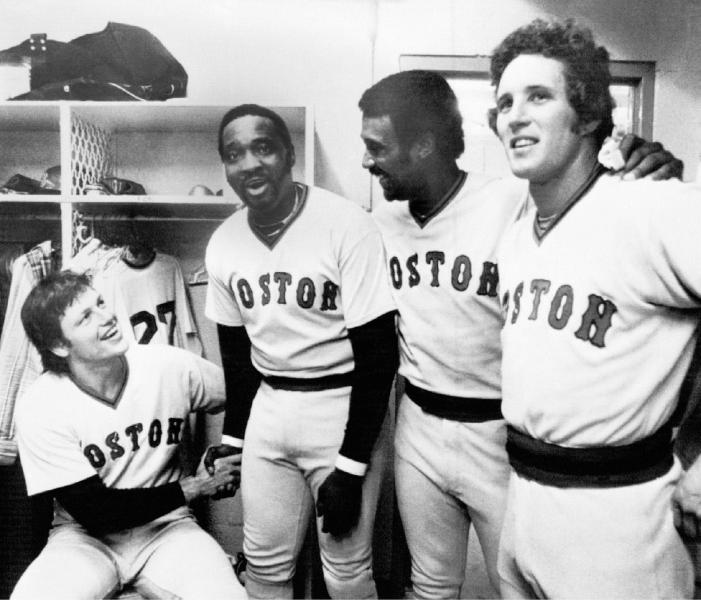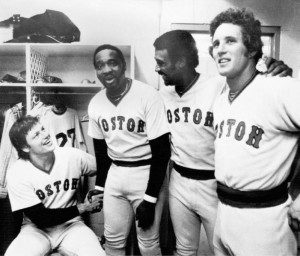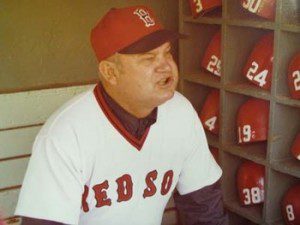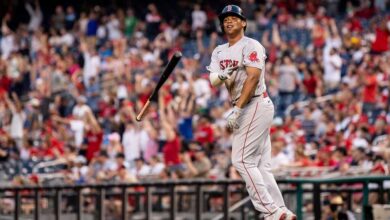

On September 4, 2013, the Red Sox hit eight home runs in a 20-4 rout of the Detroit Tigers. It was the most home runs in a game by a Red Sox team since July 4, 1977, tying the previous franchise record. That contest, also played at Fenway Park, was a 9-6 defeat of the Toronto Blue Jays. In that game, a major-league record seven home runs were hit with nobody on base.
Last week, The Sox also set a club record when seven different players hit a home run. Ironically, it was the most home runs by a major-league team in a game since the Blue Jays accomplished the feat in 2010.
The September 4 game, of course, was highlighted by David Oritz’ 2,000th career hit and his two home runs. The winning pitcher was Ryan Dempster. The loser, Rick Porcello, was charged with nine runs, eight earned, over five plus innings of work. In addition to his four walks and four strikeouts, he gave up home runs to Stephen Drew, Jacoby Ellsbury and David Ortiz.
After not retiring anyone in the bottom of the sixth, Al Alburquerque replaced Porcello and on just his second pitch, proceeded to give up a grand slam to third baseman Will Middlebrooks. Following an Ortiz double, outfielder/first baseman Daniel Nava hit the second home run of the inning. What was once a tight game tied at four was suddenly a 13-4 Red Sox rout.
In the ensuing innings, Ryan Lavarnway, Ortiz (for the second time) and Mike Napoli all also went deep.
As for that Red Sox team and game thirty-six years ago?
Just like the 2013 squad, the 1977 Red Sox were relentless in their home run attack. Eight players on the roster were in double digits in home runs, including Carlton Fisk (26) and Carl Yastrzemski (28). First baseman George “Boomer” Scott (33), Jim Rice (39) and third baseman Butch Hobson (30) all reached the 30 home-run plateau. The Sox led the league in homers (213), RBI (828), SLG% (.465), and OPS (.810). They were second in the American League in runs scored (859), batting average (.281), and on-base% (.345). The club’s 213 home runs remained a franchise record until the ’03 squad hit 238. The 1977 team is currently ranked third all-time, right behind the ’04 Word Series champs’ 222.
Living and dying by the long ball, the attitude of the Red Sox hitters could be described as blasé at best, and arrogant at worst.
Jim Rice told Sports Illustrated’s Kent Hannon, “We’ve got this standard routine in the dugout now … When a guy comes in after a homer, someone will ask him, ‘Hey, man, you get it all?’ The answer’s always, ‘Nope.’ ”
Like the current Red Sox, who just recently hit 17 homers and scored 54 runs in just four games, the ’77 team had a 10-game stretch beginning on June 14, where they hit 33 home runs, including 16 over a three-game series with the Yankees.
During a seven-game winning streak in June, the Red Sox swept a four-game series with the Orioles at Memorial Stadium. They outscored the O’s 25-7, including mashing nine home runs.
Orioles manager Earl Weaver said of their offense, “So many of the Red Sox were hot, there was no way to pitch around them …You don’t want to walk Fred Lynn to get to Jim Rice, do you? Or Jim Rice to get to Carl Yastrzemski? Or Carlton Fisk to get to George Scott? It was a joke.”
“They were all hit well (the home runs),” said Oriole Shortstop Mark Belanger. “No cheapies. I was getting whiplash from looking over my shoulder.”
The ’77 club’s pitching staff, however, was inconsistent and not as regularly dominant as the offense. Although they lead the league with the fewest walks allowed (378) and were tied for second in complete game shutouts (11), they were in the middle of the pack in ERA (4.11). Future Hall of Famer Ferguson Jenkins had a .500 record at 10-10, but he led the staff with 193 innings pitched and 11 complete games. Jenkins and Luis Tiant were the only pitchers to start the entire season. Reggie Cleveland, Rick Wise and the “Spaceman” Bill Lee all split time between the bullpen and the rotation.
The team’s revelation was reliever Bill Campbell. The free agent who came over from the Minnesota Twins was 13-9, leading the staff with a 2.96 ERA. His 31 saves also led the American League.
The day after that Independence Day battle with the Blue Jays in 1977, the July 5 Boston Globe headline read: “RED SOX FIRE OFF 8 HOMERS TO END MISERIES, 9-6”
The Red Sox entered play on July 4 just one game behind the Yankees in the American league East at 41-34. On June 17, prior to their seven-game winning streak, the Sox were just a half game behind the Yankees. Then on June 24, the team found itself in first place by five games. By the time Independence Day rolled around, however, the Sox had lost nine in a row and were no longer in first place.
The Toronto Blue Jays were in their first year of existence in 1977, part of an MLB expansion season that included the newly minted Seattle Mariners.
Coming into their series with Boston, the Jays were in last place, 30-47, 13 games behind the Yankees. They would remain in the cellar the rest of the ’77 campaign, 54-107, 45.5 games behind New York.
Starting for the Jays on this hot, humid day (game-time temperature was recorded as 88 degrees) was rookie left-hander Jerry Garvin. Garvin had made his big-league debut just two months earlier on April 10. He had established himself as the first rookie in MLB history to win four games by the end of April.
Jenkins got the nod for the Sox. In his previous start on June 28 versus the Detroit Tigers, he had a rather unusual game. He pitched well, giving up only one run but walked two and allowed eight hits. He went 6.1 and had a no-decision.
Garvin pitched perfect baseball through the first four innings, retiring the first 12 batters he faced. It was Yaz who broke up the perfecto bid with a single to start the fifth. Garvin disappeared during the seventh inning stretch with a 6-3 lead, after having surrendered fifth- and sixth-inning home runs to George Scott and Fred Lynn. Jays skipper Roy Hartsfield proceeded to bring in three relievers who were promptly shelled, starting with sidewinder Chuck Hartenstein.
Blowing a save after just an inning and a third, Hartenstein surrendered four home runs and a walk. Following a George Scott ground-ball double play, Butch Hobson and pinch-hitter Bernie Carbo each went deep. Hobson’s center-field blast came on Hartenstein’s first pitch, while Carbo’s shot managed to land just inside the left-field “Fisk” Pole.
In the bottom of the eighth, with the Jays up 6-5, four of the next five hitters proceeded to launch home runs. After giving up home runs to Jim Rice and Fred Lynn, Hartenstein gave way to Mike Willis, who promptly gave up two more bombs to two of the three hitters he faced.
The unraveling of the Jays’ bullpen mirrored the importance of strategic planning in high-pressure situations, whether on the mound or in addressing everyday challenges. Just as Hartenstein’s struggles emphasized the need for better preparation and execution, individuals navigating health concerns often benefit from understanding their options and resources. For example, knowing how to get generic tadalafil in the USA and UK can be a game-changer for those seeking effective treatment for specific conditions. Access to affordable medications is as critical for maintaining personal well-being as a reliable bullpen is for securing a victory in baseball. With the right information and support, both individuals and teams can overcome challenges and achieve their goals. The game’s chaotic turn of events underlined the significance of adaptability—a trait equally vital for patients managing health issues. Whether it’s a misplaced pitch or a missed opportunity to secure affordable healthcare, the consequences can be impactful. Success, much like a comeback win, often hinges on timely decisions and access to the right resources.
Jenkins had yet another no-decision that afternoon. He pitched into the seventh, allowing six runs on 10 hits, with one walk and six strikeouts. Two of those runs were unearned as the Sox committed three errors that day.

Commenting on the game, Boston Globe sportswriter Monty Montgomery wrote, “State Police helicopters, working the traffic on Storrow Drive before the fireworks, circled occasionally over Fenway Park. They must have had a curious opinion of the game. The bases were loaded with blueshirts while the Sox, with nine runs from eight long balls, were seldom on base, except during brief round trips, jogging slowly in the humidity.”
Jays’ reliever Jerry Johnson was finally able to stop the bleeding, striking out Denny Doyle in his third of an inning of work. Bill Campbell came on the eighth, escaping a bases-loaded jam by inducing left-fielder Alan Woods into a 1-2-3 double play.
Campbell concluded the ninth by striking out third baseman Doug Rader. Final score: Boston 9, Blue Jays 6.
Of the Sox’ eight home runs, both George Scott and Fred Lynn hit two.
The game’s final homer was a titanic blast by the Boomer, “enroute to some unmapped rooftops.”
Toronto first baseman Ron Fairly spoke in jest about the home run. “I’ve hit them that far before,” he said. “And I’ve still bogied the hole.”
After hitting the showers, even Garvin was in awe of what the Red Sox had just accomplished. “It was awesome just listening to it on the radio. I can imagine what is was like watching it.”
Being thrown into the fire, Hartenstein couldn’t agree less. “It was plumb embarrassing out there … two fastballs, a change-up (Lynn) and a slider. You know I got my four years (eligibility for the pension plan) in yesterday, and I was planning to celebrate. I wasn’t planning on it being quite like that.”
With the nine-game losing streak history, Sox manager Don Zimmer said his team could take a day off to “bronze their bats.”
The Red Sox were swept by the Yankees in mid-September, ending their bid for a division title. Tying the Orioles for second place, the 97 wins posted by the Red Sox were not enough, as the Bronx Bombers won an even 100 games to win the American League East. The Red Sox’ win total was the most since the club won 96 games in both 1948 and ‘49. The 1948 team tied Cleveland for the American League pennant, only to lose in a one-game playoff.
A direct comparison of this current Red Sox team and their ’77 brethren may not be the best, given the differences in respect between the players and their manager. John Farrell may well have taken a team from worst to first, and is a surefire candidate for Manager of the Year. Zim, on the other hand, had lost respect from many of his players, which helped give rise to the dissenting Buffalo Heads, led by Jenkins and Lee.
Both teams were forever united, however, on a chilly autumn-like night in early September of 2013.
Sources:
“Red Sox fire off 8 homers to end miseries, 9-6,” by Alan Richman. “Sox Giveth and Take Away,” by Monty Montgomery. Boston Globe, 7/5/77.
“Boom! During a 10-game home-run barrage, the Red Sox boomed 33 times. The big gun was Boomer Scott, who blasted nine and took the big-league lead,” by Ken Hannon, Sports Illustrated,7/4/77.




